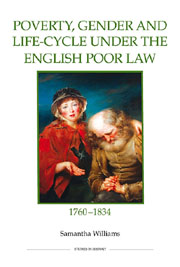Book contents
- Frontmatter
- Contents
- List of figures
- List of tables
- Dedication
- Acknowledgements
- Abbreviations
- Map 1 Bedfordshire, c.1834
- Introduction
- 1 People, place and poverty
- 2 Policy and paupers
- 3 Paying for poverty
- 4 Gender, life-cycle and the life-course
- 5 Work, unemployment and the makeshift economy
- Conclusion
- Bibliography
- Index
4 - Gender, life-cycle and the life-course
Published online by Cambridge University Press: 05 February 2013
- Frontmatter
- Contents
- List of figures
- List of tables
- Dedication
- Acknowledgements
- Abbreviations
- Map 1 Bedfordshire, c.1834
- Introduction
- 1 People, place and poverty
- 2 Policy and paupers
- 3 Paying for poverty
- 4 Gender, life-cycle and the life-course
- 5 Work, unemployment and the makeshift economy
- Conclusion
- Bibliography
- Index
Summary
Poverty was gendered and overwhelmingly life-cycle related. This chapter presents research on the life-cycle and life-course nature of poverty, drawing upon the pauper biographies of almost 250 pensioners, qualitatively and longitudinally. At least 85 per cent of all pensioners were elderly individuals or elderly couples, couple-headed families or lone parents, and a few were orphans. A snapshot approach might reveal a greater variety of reasons for the receipt of poor relief, over and above regular weekly pension payments and to those not suffering a life-cycle crisis, particularly sickness. However, in terms of the sheer weight of expenditure and the duration of relief, life-cycle-related pensioners dominated relief lists throughout the period. Gender was also particularly important. Access to regular poor relief was heavily gendered: many more women were relieved than men. Young widows and unmarried mothers accounted for more than four-fifths of lone parent pensioners and elderly women were more than twice as likely to be relieved as old men. However, by the end of the period elderly men became increasingly vulnerable as they were marginalised from an over-stocked labour market. A significant number of those relieved long-term, of those experiencing heavily pauperised life-courses, were also women. The extent to which kin were able to assist their poor relatives, as well as whether one generation passed on their poverty to the next, are also significant factors in a life-cycle approach to poverty.
- Type
- Chapter
- Information
- Publisher: Boydell & BrewerPrint publication year: 2011



